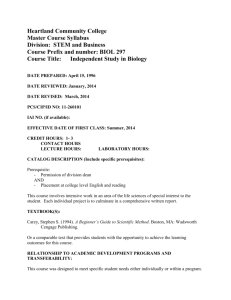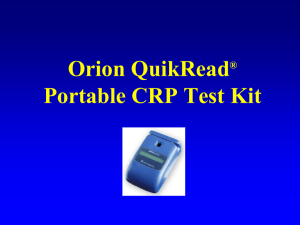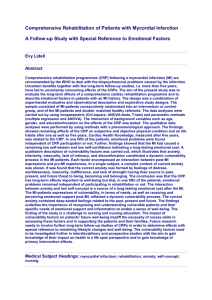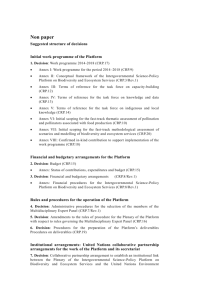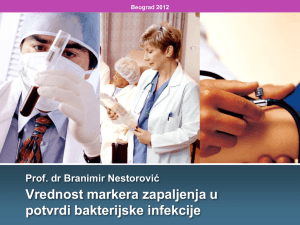C-reactive protein across the menstrual cycle
advertisement
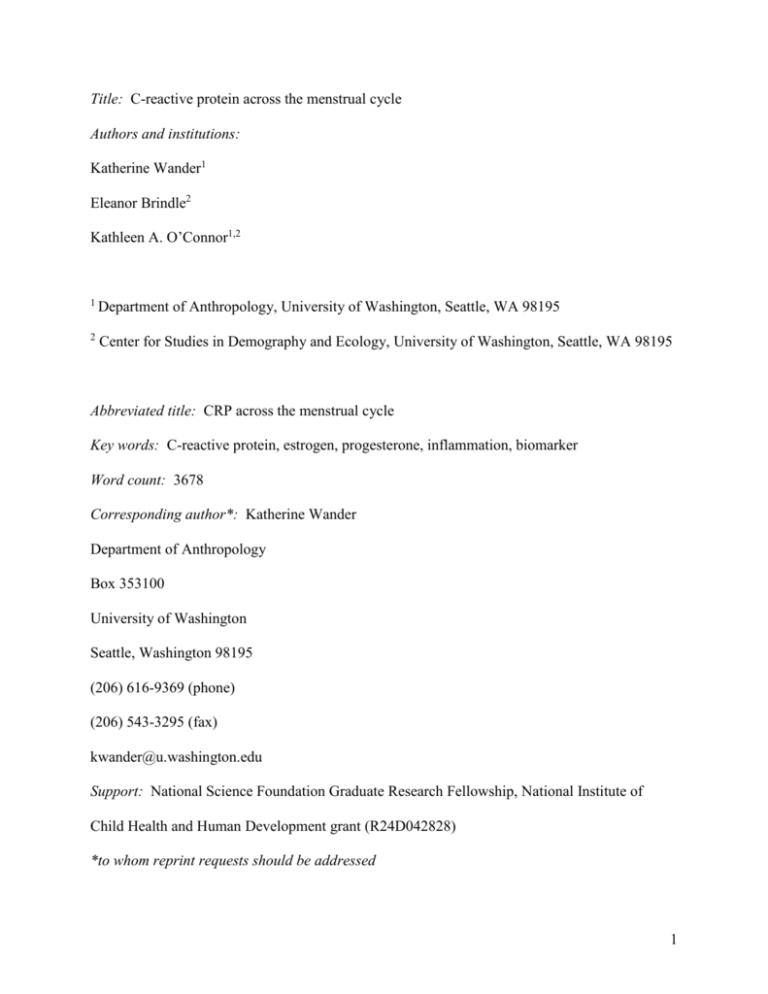
Title: C-reactive protein across the menstrual cycle Authors and institutions: Katherine Wander1 Eleanor Brindle2 Kathleen A. O’Connor1,2 1 Department of Anthropology, University of Washington, Seattle, WA 98195 2 Center for Studies in Demography and Ecology, University of Washington, Seattle, WA 98195 Abbreviated title: CRP across the menstrual cycle Key words: C-reactive protein, estrogen, progesterone, inflammation, biomarker Word count: 3678 Corresponding author*: Katherine Wander Department of Anthropology Box 353100 University of Washington Seattle, Washington 98195 (206) 616-9369 (phone) (206) 543-3295 (fax) kwander@u.washington.edu Support: National Science Foundation Graduate Research Fellowship, National Institute of Child Health and Human Development grant (R24D042828) *to whom reprint requests should be addressed 1 Abstract Context: C-reactive protein (CRP) is a widely-used, sensitive biomarker of inflammation. Studies conducted among users of exogenous hormones suggest that estrogen increases CRP, while progesterone decreases CRP. Examinations of CRP in cycling women suggest the opposite: CRP has a negative relationship with endogenous estrogen and a positive relationship with endogenous progesterone. Objective: To evaluate the effect of menstrual cycle-related hormone changes and events (menstruation and ovulation) on CRP. Design: Urine and blood samples from twelve days during the menstrual cycle were assayed for CRP, progesterone, estrogen, and follicle stimulating hormone. Ovulation day was identified using hormone levels. Presence or absence of menses was reported by subjects. Participants: Collections were made across one or two cycles from eight normally-cycling, non-contracepting participants. Main Outcome Measures: Relationships between CRP and predictors (which, based on literature review, included estrogen, progesterone, follicle stimulating hormone, menses, and ovulation) were tested using random-effects linear regression. Results: All cycles were ovulatory; day of ovulation was identified for nine cycles. A ten-fold increase in progesterone was associated with a 23% increase in CRP (p = .01), a ten-fold increase in estrogen was associated with a 29% decrease in CRP (p = .05), and menses was associated with a 17% increase in CRP (p = .18); no association between ovulation or FSH and CRP was found. 2 Conclusions: Endogenous estrogen is associated with decreases in CRP; endogenous progesterone is associated with increases in CRP. Hormone changes across the menstrual cycle should be controlled for in future studies evaluating CRP. 3 Introduction C-reactive protein (CRP) plays a role in the acute phase response, characterized by inflammation in response to injury or infection. CRP concentrations are used as a reliable indicator of ongoing infection. CRP acts to opsonize bacteria and damaged host cells and activates the complement cascade; upon injury or infection, CRP levels increase up to 10,000fold. In the absence of infection, CRP is used as a biomarker of baseline inflammation. CRP is uniquely responsive and sensitive, and can be seen as a direct indication of inflammatory stimuli (for recent review, see 1). Elevations in baseline CRP are associated with increased risk of cardiovascular disease (2) and diabetes (3). Individuals’ CRP measures increase dramatically during bacterial infection, and less dramatically during viral infection (4). Absent infection, baseline CRP measures are moderately stable over time (5). Weight loss is associated with declines in baseline CRP (6). There is no systematic diurnal (7) or seasonal (8) variation in CRP within individuals. Between individuals, CRP concentrations vary independently with many attributes. Among adults, CRP is positively associated with age (4), females have higher CRP than males (4, 9), and CRP is negatively associated with birthweight (10). CRP is negatively associated with high-density lipoprotein cholesterol (4), decreases with increasing measures of physical fitness (11), increases with body mass index (12), and is higher among smokers than nonsmokers (4). Oral contraceptive (OC) use (13, 14) and hormone replacement therapy (HRT) (14, 15) consistently elevate CRP, whether the preparation includes progesterone and estrogen or estrogen alone. Estrogen administration is also associated with increases in CRP among men being treated for prostate cancer (16). Such studies repeatedly demonstrate that exogenous estrogen can increase CRP. Dose and delivery method influence exogenous estrogen’s effect on 4 CRP: one study found significant increases in CRP among women taking a higher estrogen HRT preparation and significant decreases among women taking a lower estrogen preparation (17); transdermally-administered HRT shows no effect on CRP (18, 19). Comparisons of different HRT preparations suggest that exogenous progesterone may be anti-inflammatory (20, 21, but see 22). A pro-inflammatory effect of exogenous progesterone administration has been reported in men (23). The use of progesterones of different types complicates these studies, as progestational agents differ in receptor affinity and glucocorticoid effects (24). Combination estrogen/progesterone HRT preparations have been found to have opposite effects on CRP depending on the type of progesterone used, with the HRT preparation which included the “pure progestational” (so named because it interacts only with progesterone receptors and has no glucocorticoid effects) Nomegestrol acetate associated with a decrease in CRP, despite the inclusion of estrogen (24). Although supported by far fewer studies, endogenous hormones appear to have opposite effects on CRP than suggested by the above studies. Jilma and colleagues (25) examined measures from 18 women taken in the follicular phase, at mid-cycle, and in the luteal phase of one menstrual cycle, and found a significant (univariate) association between individuals’ relative increase in progesterone and CRP from the follicular phase to mid-cycle (r = .60, p = .01), as well as from the follicular phase to the luteal phase (r = .71, p = .001). Blum and colleagues (26) examined 15 measures from 15 women across one menstrual cycle. In random effects maximum likelihood regression, increasing estrogen was associated with decreasing CRP (β = -.23, p < .001; univariate) such that a ten-fold increase in estrogen was associated with a 41% decrease in CRP. The effect of progesterone on CRP in this study was not significant (p = .15). Although subjects were sampled daily around ovulation, a potential effect of ovulation 5 per se on CRP concentration was not discussed. CRP concentrations in this study were highest during menstruation; independent effects of estrogen and menses were not tested. The results of these studies are inconsistent with the numerous studies examining the effects of exogenous hormone administration on CRP: orally-administered estrogen at most doses is associated with elevations in CRP (13, 14, 15, 16), endogenous estrogen seems to be associated with decreases in CRP (26); exogenous progesterone may be associated with decreases in CRP (20, 21, 24), endogenous progesterone seems to be associated with increases in CRP (25). Neither study examining the effects of endogenous hormones reports any evaluation of confounding between the effects of estrogen and progesterone, despite the fact that changes in these hormones regularly co-occur across the menstrual cycle. Further, these studies do not evaluate potential independent effects of menses or ovulation, despite good reason to expect these events to substantially affect inflammation. Ovulation and menstruation have both been described as “inflammatory” events. Inflammatory mediators and leukocytes play important roles in folliculogenesis and follicular rupture. Similarly, prostaglandins and leukocytes play a direct role in accomplishing menstruation (for recent reviews, see 27, 28). As such, an effect of these menstrual cycle events on circulating concentrations of CRP bears exploration. Further, because elevations in follicle stimulating hormone (FSH) are typically associated with both menstruation and ovulation (29), it is possible that changes in this hormone may explain any association between those cycle events and CRP; this merits investigation. Thus, this pilot study was undertaken to verify the unexpected effects of endogenous reproductive steroids on CRP, to evaluate potential effects of menses, ovulation, and FSH on CRP, and to evaluate potential confounding and interaction in these relationships. 6 Methods Participants and specimen collection Three female participants collected urine and capillary dried blood spots (DBS) for two months (24 collections per subject), and five made urine and DBS collections for one month (12 collections per subject). Participants were excluded from the study if they were taking any exogenous hormones or statins, or if they were taking more than occasional anti-inflammatory medication. Paired DBS and urine collections were made every Monday, Wednesday and Friday during a subject’s collection period. Two subjects made additional daily urine collections (12 DBS and 28 urine collections per subject). Procedures were approved by the Institutional Review Board of the University of Washington. DBS were collected by finger stick with a sterile lancet. Spots of blood were allowed to fall freely from the subject’s finger onto filter paper (Schleicher and Schuell #903 Specimen Collection Paper). Filter papers were allowed to dry at room temperature in open air for one to three days, then were frozen with desiccant until assay. Within approximately one hour of DBS collection, urine was collected in a plastic vial and refrigerated. At intervals of approximately two weeks, urine specific gravity measures were taken and a 600 µL aliquot was made and refrigerated until assay. To address the possibility that DBS collection procedures were invasive enough to evoke some measure of inflammatory response, subjects’ start days were assigned irrespective of cycle day, so that no collection day systematically co-occurred with any cycle day. Further, collections were not made over the weekend, providing a longer interval for clearance of any collection- related increases in CRP than during the week and allowing us to test for regularly belowaverage CRP on Mondays. Assays DBS were assayed for CRP using an enzyme immunoassay described elsewhere (30). DBS measures using this assay correlate highly with serum measures of CRP (r = .96). The lower limit of detection for this assay is .028 mg/L (1.33 nmol/L). The intra-assay coefficient of variation (CV) at high concentration is 6.4% and low concentration is 5.1%; the inter-assay CV at high concentration is 6.9% and at low concentration is 9.5%. Urine samples were assayed for estrone glucuronide (E1G) and pregnanediol 3-glucuronide (PDG), the major urinary metabolites of estradiol (E2) and progesterone (P4), respectively, using methods described elsewhere (31, 32). Urinary steroids measured with these assays correlate highly with serum measures of E2 and P4 (r = .95 and .98, respectively). The E1G lower limit of detection is 1,452.4 pg/mL (3.1 nmol/L); the PDG assay lower limit of detection is 10.4 ng/mL (21 nmol/L). High and low concentration intra-assay CVs for the PDG assay are 9.2% and 7.1%; high and low inter-assay CVs are 10% and 7.1%. High and low concentration intra-assay CV’s for the E1G assay are 3.6% and 12.2%; high and low inter-assay CVs are 3.2% and 13.7%. Urine samples were assayed for FSH using an IEMA specific to total (free and intact) beta FSH (33). Urinary βFSH measured with this assay correlates well with serum intact FSH measures (r = .86). The FSH assay lower limit of detection is .143 ng/mL (6.8 pmol/L); high and low intraassay CVs are 2.2% and 4.1%; high and low inter-assay CVs 4.3% and 3.7%. All specimens, calibrators and controls were run in duplicate, and hormone concentrations were estimated from optical density using a four-parameter logistic model in BIOLINX 2.0 Software (Dynatech Laboratories, Inc., Chantilly, VA, USA). All urinary hormone values were adjusted by specimen specific gravity (34); E1G results were further corrected for slight assay non-parallelism using a statistical correction model (31). Identification of ovulation Cycles were identified as ovulatory or anovulatory and day of ovulation was identified using methods developed for intermittent sampling and described elsewhere (29), which rely on changes in steroid hormones. This method (modified Baird) identifies ovulation day to within two days of the true ovulation day for 93% of cycles. When a non-collection day was identified as the day of ovulation, the following collection was defined as ovulation day for these analyses. Sampling in this study provided slightly fewer samples than that used to develop these methods, so the decision rule was relaxed regarding the change in the ratio of steroid hormones necessary to identify ovulation. The protocol calls for a decrease of 60% across a five-day window. Since cycles clearly identified as ovulatory did not consistently demonstrate this magnitude decrease, but did demonstrate a 50% decrease, a 50% decrease was accepted in identifying ovulation day in these analyses. Statistical analysis Data were analyzed using StataSE 9.0 (Statacorp, College Station, TX). Statistical significance was defined as p ≤ .05; suggestive results were defined as .05 < p ≤ .20; confounding was defined as a change > 10% in the coefficient of the predictor of interest with the inclusion of a potential confounder. Relationships between CRP and other variables were analyzed using random-effects linear regression, wherein a random intercept term was estimated for each participant to account for differences between individuals. Per convention, infectionrelated increases in CRP were defined as CRP > 10 mg/L (476 mmol/L) and were excluded from analyses. Further, analyses were carried out both with and without CRP > 5 mg/L (238 mmol/L), a more conservative cut-off, as an infectious cause for this magnitude elevation is possible. Because previous work (17) demonstrates opposite effects of low and high dose estrogen on CRP, we chose to test the hypothesis that the effects of estrogen on CRP may change at high concentrations. To do this, analyses were carried out both with and without points above the 90th percentile E1G. Results Data from eleven menstrual cycles of eight female subjects were used to assess menstrual cycle-related changes in CRP. Values for E1G and PDG were available for a total of 126 data points; values for FSH were available for 124 data points. The presence or absence of menses was reported by participants for 126 data points; menses was reported as present for 37 data points. All cycles were ovulatory; day of ovulation was identifiable for nine cycles. Continuous variables (CRP, PDG, E1G, FSH) were found to have skewed distributions and were therefore transformed using a natural logarithm; within individuals, the transformed CRP values appear to be normally distributed. No subjects reported using more than occasional anti-inflammatory medication. The majority of anti-inflammatories reported were ibuprofen and acetaminophen. Only on one occasion did one subject report using aspirin; the associated collection was dropped from all analyses. No CRP concentrations exceeded 10 mg/L (476 mmol/L). Monday collections (including all collections preceded by two or more non-collection days) were tested for systematically lower than average CRP concentrations within individuals; no effect was found (β = .085, p = .26). Collection procedures did not artificially elevate CRP. Confounding was apparent between all predictors of interest for which there was a suggestive univariate effect (Table 1); only one model was ultimately used for all predictors (Table 2). All possible two-way interaction terms from the final model were tested individually. None were found to be significant; however, the interaction term coefficients for ln(PDG)*ln(E1G) (p = .06) and ln(E1G)*menses (p = .18) were suggestive. Future studies with larger sample sizes should assess interaction between these variables. According to the model presented in Table 2, controlling for E1G and menses, a ten-fold increase (as is typical for steroids across the cycles we observed) in PDG is associated with a 23% increase in CRP (p = .01). Controlling for PDG and menses, a ten-fold increase in E1G is associated with a 29% decrease in CRP (p = .05). Controlling for hormone concentrations, a suggestive increase of 17% in CRP (p = .18) is associated with the presence of menses. Rsquared values for this model were low, indicating that a small proportion of the variation between normally cycling women in CRP is explained by cycle-related variables; however, a significant proportion of the variation in CRP within a normally cycling woman is explained by these variables. The data from two subjects who made daily urine collections for one month each were used to evaluate a potential lag in the effect of estrogen on CRP. Although a small sample, results indicate that no such lag effect exists (data not shown); there were no differences in the association between E1G and CRP when E1G values for the day preceding CRP collection were substituted in the model. No association between FSH and CRP, nor any confounding between FSH and other predictors, was found. Thus, FSH was disregarded in further analyses. The expected positive associations between FSH and menses (β = .311, p = .01) and FSH and ovulation (β = .679, p = .00) were evident. No association between ovulation and CRP (β = -.055, p = .60 when included in the model in Table 2), nor any confounding between ovulation and the effect of steroids on CRP, was found. Thus, ovulation was disregarded in further analyses. No CRP values exceeded 10 mg/L (476 mmol/L); four values exceeded 5 mg/L (238 mmol/L). The final regression model was evaluated both with and without these points; their exclusion did not substantially alter the magnitude of any coefficients; the coefficient for E1G, however, loses significance without these data points (Table 3). When the highest E1G values are excluded from the analysis, the negative relationship between E1G and CRP becomes stronger, despite the reduction in sample size. The results of the regression model excluding points with E1G above the 90th percentile [E1G ≥ 101,675.0 pg/mL (47.63 mmol/L), 13 values] are shown in Table 4. Compared to the results in Table 2, coefficients for PDG and menses decrease in magnitude and significance, concomitant with a reduction in sample size; the E1G coefficient increases in magnitude and significance, such that a ten-fold increase in E1G is associated with a 43% decrease in CRP (p = .02). Discussion Within individuals, CRP concentrations are clearly associated with endogenous reproductive hormones: increases in estrogen are associated with decreases in CRP (p = .05), while increases in progesterone are associated with increases in CRP (p = .01). Independent of hormone changes, the presence of menses is associated with nonsignificant increases in CRP (p = .18). Substantial confounding is apparent between these effects; this may explain the lower magnitude of the effects reported here, compared to previous studies (25, 26). Our finding that endogenous estrogen is associated with decreases in CRP is consistent with previous work (26); this is in contrast to the many studies indicating that exogenous estrogen increases CRP (13, 14, 15, 16). Investigators draw conflicting conclusions about the extent to which changes in CRP with exogenous estrogen administration reflect an effect of estrogen on inflammation, rather than an effect solely on liver CRP production. Some interpret the failure of transdermally-administered HRT to demonstrate any effect on CRP (17) and the failure to find concomitant increases in other inflammatory markers among oral HRT users (35) to suggest estrogen ingested in large amounts has a direct, metabolic effect on liver production of CRP. However, some of these findings may be attributable to the lower sensitivity and more stringent sampling requirements of other inflammatory markers, compared to CRP (1). Demonstrated increases in multiple inflammatory markers among women using OC have been interpreted by others as elevated baseline inflammation (14). It is possible that differences between the effects of orally- and transdermally-administered estrogen are attributable to concentration-dependent effects of estrogen on inflammation, rather than to administration method per se. Transdermallyadministered estrogen may result in circulating estrogen levels which differ from orallyadministered estrogen, with different consequences for inflammation. Circulating E2 levels have been found to be lower in women using transdermal HRT than in women using oral HRT (19, 36). The same is not true for transdermal contraception (http://www.fda.gov/bbs/topics/news/2005/NEW01262.html), which may be associated with elevated CRP (14); we have found no published data directly testing this hypothesis. The contrast between studies focusing on endogenous estrogen, such as ours (and 26), and those focusing on exogenous estrogen (OC and HRT) may similarly be best explained by differences in circulating estrogen levels: estrogen levels in normally-cycling women may not often reach levels in women using OC or HRT (37), although the opposite may be true for users of low-dose OC (38). There is evidence to suggest that incremental increases in estrogen at low and high concentration have opposite effects on inflammatory markers: increases in estrogen were found to be negatively associated in vivo with CRP (17) and in vitro with monocyte interleukin (IL)-1β and IL-6 production (39) at lower estrogen levels, and positively associated at higher estrogen levels. Our finding that excluding points above the 90th percentile for estrogen strengthens the effect of estrogen on CRP further supports this hypothesis. Our observation of an anti-inflammatory effect of estrogen at most physiological levels is consistent with other observations of estrogen’s effect on the immune system: while estrogen increases production of B lymphocytes, as well as immunoglobulin production, it seems to decrease monocyte cytokine production and the inflammatory activity of neutrophils and natural killer (NK) cells (for recent review, see 40). Locally, estrogen seems to have a pro-inflammatory effect on uterine and other reproductive tissues (41), but its effect on other tissue types is consistently anti-inflammatory (see, for example, 42, 43, 44). Our finding of a positive effect of progesterone on CRP is consistent with the relationship reported by Jilma and colleagues (25), in contrast to the negative or nonexistent effect suggested by studies of exogenous hormone administration (20, 21, 24). Our finding is difficult to reconcile with many observations of progesterone’s effects on the immune system: while progesterone seems to promote the chemotactic activity of neutrophils and increase production of some inflammatory mediators (IL-6 and leukemia inhibiting factor, LIF) by monocytes (40), an overall anti-inflammatory effect is generally attributed to progesterone, which includes decreasing NK cell activity and macrophage tumor necrosis factor (TNF) α and nitric oxide synthase (NOS) production, as well as inhibiting T-cell development in the thymus and T-cell activity (for recent review, see 45). Our results suggest that increases in progesterone typical of normally cycling women have an overall inflammatory effect. Future work should focus on reconciling the observed effects of progesterone on inflammatory cells with its overall effect on systemic inflammation. We report that menstruation is associated with a suggestive increase in CRP; this is consistent with Blum and colleagues’ (26) observation of highest CRP concentrations during menstruation. Due to small sample size, our analysis lacks the power to reject alternative hypotheses at the .05 α-level; thus we interpret this result as a suggestive pro-inflammatory effect of menstruation. Studies with larger samples should anticipate a pro-inflammatory effect of menses, consistent with the non-specific immune system’s role in initiating menstruation (28). Despite the involvement of inflammatory cells and mediators in follicular rupture, ovulation does not appear to affect systemic inflammation. The possibility exists that our methods of identifying ovulation, sampling frequency, or power were inadequate to detect such an effect, but the small magnitude and high p-value of the coefficient that results from ovulation’s inclusion in our model do not suggest that this is the case. Our results indicate that studies using CRP as a biomarker should control for changes in endogenous hormone levels when sampling normally-cycling women. More generally, we suggest that when study samples include individuals who may be undergoing any transition in their reproductive life course (for example, adolescents, mothers returning to menses postpartum, or perimenopausal women), bias in hormone levels may confound results regarding baseline CRP. For example, variation in age at menarche alone could result in systematic variation in CRP among an adolescent female sample. To understand how other factors affect CRP among adolescents, menstrual status or age at menarche should therefore be controlled. In summary, changes in endogenous estrogen and progesterone within the menstrual cycle are significantly and independently associated with changes in CRP: progesterone increases CRP and estrogen decreases CRP; menstruation may increase CRP. Overall, these changes are consistent with observed interactions between the reproductive and immune systems. The patterns we observed are not consistent with the effects of exogenously administered hormones; this may be attributable in part to concentration-dependent effects of estrogen on CRP production. Our results are consistent with those of others examining endogenous reproductive steroid levels (25, 26), and our analysis expands on them, providing a single model of the independent effects of endogenous hormones and menstrual cycle events on CRP. These results suggest that studies using CRP as a biomarker among reproductive-age women should account for endogenous hormonal changes and menstruation in sampling and analysis. Acknowledgments This material is based upon work supported under a National Science Foundation Graduate Research Fellowship (KW). This work was supported by a NICHD grant (R24D042828) to the Center for Studies in Demography and Ecology at the University of Washington. We thank Jennifer Aranda, Masako Fujita, Steven Goodreau, Anita Rocha, Bettina Shell-Duncan, and Jane Shofer for their help in the preparation of this manuscript. References Cited (1) Pepys MB, Hirschfield GM 2003 C-reactive protein: A critical update. J Clin Invest 111:1805-1812 (2) Danesh J, Whincup P, Walker M, Lennon L, Thomson A, Appleby P, Gallimore JR, Pepys MB 2000 Low grade inflammation and coronary heart disease: Prospective study and updated meta-analyses. Br Med J 321:199-204 (3) Pradhan AD, Manson JE, Rifai N, Buring JE, Ridker PM 2001 C-reactive protein, interleukin 6, and risk of developing type 2 diabetes mellitus. JAMA 286:327-334 (4) de Maat MPM, Kluft C 2001 Determinants of C-reactive protein concentration in blood. Ital Heart J 2:189-195 (5) Ockene IS, Matthews CE, Rifai N, Ridker PM, Reed G, Stanek E 2001 Variability and classification accuracy of serial high-sensitivity C-reactive protein measurements in healthy adults. Clin Chem 47:444-450 (6) Tchernof A, Nolan A, Sites CK, Ades PA, Poehlman ET 2002 Weight loss reduced Creactive protein levels in obese postmenopausal women. Circulation 105:564-569 (7) Meier-Ewert HK, Ridker PM, Rifai N, Price N, Dinges DF, Mullington JM 2001 Absence of diurnal variation of C-reactive protein concentrations in healthy human subjects. Clin Chem 47:426-430 (8) Fröhlich M, Sund M, Thorand B, Hutchinson WL, Pepys MB, Koenig W 2002 Lack of seasonal variation in C-reactive protein. Clin Chem 48:575-577 (9) Ford ES, Giles WH, Myers GL, Rifai N, Ridker PM, Mannino DM 2003 C-reactive protein concentration distribution among US children and young adults: Findings from the National Health and Nutrition Examination Survey, 1999-2000. Clin Chem 49:1353-1357 (10) Sattar N, McConnachie A, O'Reilly D, Upton MN, Greer IA, Davey Smith G, Watt G 2004 Inverse association between birth weight and C-reactive protein concentrations in the MIDSPAN Family Study. Arterioscler Thromb Vasc Biol 24:583-7 (11) LaMonte MJ, Durstine JL, Yanowitz FG, Lim T, DuBose KD, Davis P, Ainsworth BE 2002 Cardiorespiratory fitness and C-reactive protein among a tri-ethnic sample of women. Circulation 106:403-406 (12) Visser M, Bouter LM, McQuillen GM, Wener MH, Harris TB 1999 Elevated C-reactive protein levels in overweight and obese adults. JAMA 282:2131-2135 (13) Dreon DM, Slavin JL, Phinney SD 2002 Oral contraceptive use and increased plasma concentration of C-reactive protein. Life Sci 73:1245-1252 (14) Kluft C, Gevers Leuven JA, Helmerhorst FM, Krans HMJ 2002 Pro-inflammatory effects of oestrogens during use of oral contraceptives and hormones replacement treatment. Vascul Pharmacol 39:149-154 (15) Walsh BW, Paul S, Wild RA, Dean RA, Tracy RP, Cox DA, Anderson PW 2000 The effects of hormone replacement therapy and raloxifene on C-reactive protein and homocysteine in healthy postmenopausal women: A randomized, controlled trial. J Clin Endocrinol Metab 85:214-218 (16) Kovacs A, Henriksson P, Hamsten A, Wallén H, Björkegren J, Tornvall P 2005 Hormonal regulation of circulating C-reactive protein in men. Clin Chem 51:911-913 (17) Prestwood KM, Unson C, Kulldorff M, Cushman M 2004 The effect of different doses of micronized 17β-estradiol on C-reactive protein, interleukin-6, and lipids in older women. J Gerontol 59:827-832 (18) Decensi A, Omodei U, Robertson C, Bonanni B, Guerrieri-Gonzaga A, Ramazzotto F, Johansson H, Mora S, Sandri MT, Cazzaniga M, Franchi M, Pecorelli S 2002 Effect of transdermal estradiol and oral conjugated estrogen on C-reactive protein in retinoid-placebo trial in healthy women. Circulation 106:1224-1228 (19) Ropponen A, Aittomaki K, Vihma V, Tikkanen MJ, Ylikorkala O 2005 Effects of oral and transdermal estradiol administration on levels of sex hormone-binding globulin in postmenopausal women with and without a history of intrahepatic cholestasis of pregnancy. J Clin Endocrinol Metab 90:3431-3434 (20) Cushman M, Mailahn EN, Psaty BM, Kuller LH, Dobs AS, Tracy RP 1999 Hormone replacement therapy, inflammation and hemostasis in elderly women. Arterioscler Thromb Vasc Biol 19:893-899 (21) Skouby SO, Gram J, Andersen LF, Sidelmann J, Petersen KR, Jespersen J 2002 Hormone replacement therapy: Estrogen and progestin effects on plasma C-reactive protein concentrations. Am J Obstet Gynecol 186:969-977 (22) Ridker PM, Hennekens CH, Rifai N, Buring JE, Manson JE 1999 Hormone replacement therapy and increased plasma concentration of C-reactive protein. Circulation 100:713-716 (23) Zitzmann M, Erren M, Kamischke A, Simoni M, Nieschlag E 2005 Endogenous progesterone and the exogenous progestin norethisterone enanthate are associated with a proinflammatory profile in healthy men. J Clin Endocrinol Metab 90:6603-6608 (24) Gol M, Akan P, Dogan E, Karas C, Saygili U, Posaci C 2006 Effects of estrogen, raloxifene, and hormone replacement therapy on serum C-reactive protein and homocysteine levels. Maturitas 53:252-259 (25) Jilma B, Dirnberger E, Löscher I, Rumplmayr A, Hildebrandt J, Eichler H, Kapiotis S, Wagner OF 1997 Menstrual cycle-associated changes in blood levels of interleukin-6, α 1 acid glycoprotein, and C-reactive protein. J Lab Clin Med 130:69-75 (26) Blum CA, Müller B, Huber P, Kraenzlin M, Schindler C, De Geyter C, Keller U, Puder JJ 2005 Low-grade inflammation and estimates of insulin resistance during the menstrual cycle in lean and overweight women. J Clin Endocrinol Metab 90:3230-3235 (27) Bukulmez O, Arici A 2000 Leukocytes in ovarian function. Hum Reprod Update 6:1-15 (28) Critchley HOD, Kelly RW, Brenner RM, Baird DT 2001 The endocrinology of menstruation—a role for the immune system. Clin Endocrinol (Oxf) 55:701-710 (29) O'Connor KA, Brindle E, Miller RC, Shofer JB, Ferrell RJ, Klein NA, Soules MR, Holman DJ, Mansfield PK, Wood JW 2006 Ovulation detection methods for urinary hormones: precision, daily and intermittent sampling and a combined hierarchical method. Hum Reprod 21:1442-52 (30) McDade TW, Burhop J, Dohnal J 2004 High-sensitivity enzyme immunoassay for Creactive protein in dried blood spots. Clin Chem 50:652-654 (31) O’Connor KA, Brindle E, Shofer JB, Miller RC, Klein NA, Soules MR, Campbell KL, Mar C, Handcock MS 2004 Statistical correction for non-parallelism is a urinary enzyme immunoassay. J Immunoassay Immunochem 25:259-278 (32) O’Connor KA, Brindle E, Holman DJ, Klein NA, Soules MR, Campbell KL, Kohen F, Munro CJ, Shofer JB, Lasley BL, Wood JW 2003 Urinary estrone conjugate and pregnanediol 3-glucuronide enzyme immunoassays for population research. Clin Chem 49:1139-1148 (33) Brindle E, Miller RC, Shofer JB, Klein NA, Soules MR, O’Connor KA 2006 Urinary beta-luteinizing hormone and beta-follicle stimulating hormone immunoenzymometric assays for population research. Clin Biochem doi: 10.1016/j.clinbiochem.2006.08.009 (34) Miller RC, Brindle E, Holman DJ, Shofer J, Klein NA, Soules MR, O’Connor KA 2004 Comparison of specific gravity and creatinine for normalizing urinary reproductive hormone concentrations. Clin Chem 50:924-932 (35) Silvestri A, Gebara O, Vitale C, Wajngarten M, Leonardo F, Ramires JAF, Fini M, Mercuro G, Rosano GMC 2003 Increased levels of C-reactive protein after oral hormone replacement therapy may not be related to an increased inflammation response. Circulation 107:3165-3169 (36) Geisler J, Omsjø IH, Helle SI, Ekse D, Silsand T, Lønning PE 1999 Plasma oestrogen fractions in postmenopausal women receiving hormone replacement therapy: influence of route of administration and cigarette smoking. J Endocrinol 162:265-270 (37) Salazar EL, Sojo-Aranda I, Lopez R, Salcedo M 2001 The evidence for an etiological relationship between oral contraceptive use and dysplastic change in cervical tissue. Gynecol Endocrinol 15:23-28 (38) Rabe T, Nitsche DC, Runnebaum B 1997 The effects of monophasic and triphasic oral contraceptives on ovarian function and endometrial thickness. Eur J Contracept Reprod Health Care 2:39-51 (39) Rogers A, Eastell R 2001 The effect of 17β-estradiol on production of cytokines in cultures of peripheral blood. Bone 29:30-34 (40) Bouman A, Heineman MJ, Faas MM 2005 Sex hormones and the immune response in humans. Human Reproduction Update 11:411-425 (41) Tibbetts TA, Conneely OM, O’Malley BW 1999 Progesterone via its receptor antagonizes the pro-inflammatory activity of estrogen in the mouse uterus. Biol Reprod 60:1158-1165 (42) Ashcroft GS, Greenwell-Wild T, Horan MA, Wahi SM, Ferguson MWJ 1999 Topical estrogen accelerates cutaneous wound healing in aged humans associated with an altered inflammatory response. Am J Pathol 155:1137-1146 (43) Miyamoto N, Mandai M, Suzuma I, Suzuma K, Kobayashi K, Honda Y 1999 Estrogen protects against cellular infiltration by reducing the expression of E-selectin and IL-6 in endotoxin-induced uveitis. J Immunol 163:374-379 (44) Vegeto E, Bonincontro C, Pollio G, Sala A, Viappiani S, Nardi F, Brusadelli A, Viviani B, Ciana P, Maggi A 2001 Estrogen prevents the lipopolysaccharide-induced inflammatory response in microglia. J Neurosci 21:1809-1818 (45) Roberts CW, Walker W, Alexander J 2001 Sex-associated hormones and immunity to protozoan parasites. Clin Microbiol Rev 14:476-488 Tables Table 1: Evaluation of confounding Univariate associations with ln(CRP) (β, p-value): ln(PDG) ln(E1G ) Menses .030, .33 -.093, .16 .179, .10 Bivariate confounders: ln(PDG) ----- -.191, .01 .214, .06 ln(E1G) .088, .01 ----- .154, .18 Menses .052, .07 -.045, .49 ----- FSH .027, .40 -.096, .15 .169, .14 Ovulation .032, .29 -.080, .24 .169, .13 Results of random-effects linear regression show substantial confounding between these three predictors of interest. CRP = C-reactive protein; PDG = pregnanediol 3 glucuronide, reflects serum progesterone levels; E1G = estrone glucuronide, reflects serum estradiol levels The top row lists the coefficients and p-values for univariate associations between a variable and CRP, the lower rows show how those coefficients and p-values change with the inclusion of each potential confounder (listed to the left). Thus, for example, the coefficient for E1G increases in magnitude, from -.093 to -.191, and significance, from p = .16 to p = .01, with the inclusion of PDG in the model. Table 2: Relationship between CRP and menstrual cycle variables Coefficient P-value 95% Confidence interval ln(PDG) .090 .01 .023, .157 ln(E1G) -.148 .05 -.297, -.000 Menses .156 .18 -.074, .387 Outcome = ln(CRP) R2 within = .0754, R2 between = .0005, R2 overall = .0053 All continuous variables were natural log transformed; analyses were conducted with random effects linear regression. CRP = C-reactive protein; PDG = pregnanediol 3 glucuronide, reflects serum progesterone levels; E1G = estrone glucuronide, reflects serum estradiol levels Table 3: Effect of excluding elevated CRP measures Coefficient P-value 95% Confidence interval ln(PDG) .081 .01 .017, .146 ln(E1G) -.107 .12 -.241, .027 Menses .182 .11 -.037, .401 Outcome = ln(CRP) R2 within = .0867, R2 between = .0368, R2 overall = .0001 After excluding all points for which CRP ≥ 5 mg/L, all continuous variables were natural log transformed and analyzed with random effects linear regression. CRP = C-reactive protein; PDG = pregnanediol 3 glucuronide, reflects serum progesterone levels; E1G = estrone glucuronide, reflects serum estradiol levels Table 4: Effect of excluding high estrogen values Coefficient P-value 95% Confidence interval ln(PDG) .088 .04 .003, .173 ln(E1G) -.242 .02 -.441, -.041 Menses .099 .44 -.151, .349 Outcome = ln(CRP) R2 within = .0793, R2 between = .0095, R2 overall = .0154 After excluding points for which E1G ≥ 101,675.0 pg/mL, all continuous variables were natural log transformed and analyzed with random effects linear regression. CRP = Creactive protein; PDG = pregnanediol 3 glucuronide, reflects serum progesterone levels; E1G = estrone glucuronide, reflects serum estradiol levels

